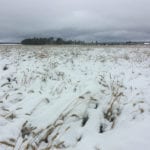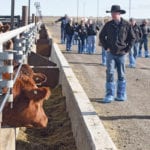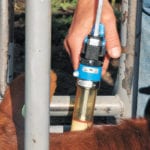It’s not necessarily economical for ranchers to raise their own replacement heifers rather than buy them. However, the reverse is also true, and research economist Kathy Larson says it’s wise to analyze the costs before deciding whether to raise or buy females for the herd. Larson told those on an Oct. 3 webinar, organized by […] Read more
 Livestock Management
Livestock Management
Decision to buy or raise heifers requires careful analysis
Bibersteinia trehalosi can cause sudden deaths in heifers
Imagine you go out to check some heifers and find one animal has died suddenly. All of the animals looked great yesterday and there have been no recent illnesses or treatments. They have all been on a good vaccination program and seemed to be doing fine. We might suspect bloat or lightning, but there is […] Read more
Alberta college now VBP+ certified
Lakeland College in Vermilion, Alta., attained its Verified Beef Production Plus certification last week, making it the first Alberta post-secondary institution to do so. VBP+ is a national on-farm food safety program that requires certificate holders to comply with specific practices and standards for food safety, animal care, environmental stewardship and biosecurity. The certification applies […] Read more

Alberta feed market flooded with grain
Feed grain prices in Alberta have come down as producers have rushed to sell downgraded crops. “Last week the phones were blowing up…right now I think we’re seeing some better weather, so everyone’s outside and the phones are probably going to light up again next week,” said Nelson Neumann, grain trader with Agfinity in Stony […] Read more
Weekly Manitoba cattle report
Manitoba’s cattle auctions were busy during the week ended Oct. 19, as the fall run hit its full stride. “I think every barn had their biggest sale of the year so far,” said Rick Wright of Heartland Order Buying. While big volumes are normal for this time of year, he said cattle were coming to […] Read more

Dugouts should be checked before freeze-up
Early October’s flirtation with winter could be a good reminder to check farm and ranch dugouts before freeze-up. Dan Benson, agricultural water specialist with Alberta Agriculture, said dugout maintenance depends on whether people depend upon them as a year-round water source or only seasonally. Either way, it’s a good idea to do a fall inspection. […] Read more

Livestock research enters new era in Sask.
CLAVET, Sask. — The University of Saskatchewan’s Livestock and Forage Centre of Excellence is being hailed as a world-class complex of field and science laboratories that is expected to trail blaze innovative research, hands-on learning and teaching, and industry engagement in all aspects of livestock and forage production on the Prairies. The $38 million facility, […] Read more

American beef capitalizes on global drought
Dryness is particularly bad in Europe and Australia, but U.S. production has increased three percent from last year
Global beef exports are strong, but drought throughout many cattle producing countries is taking a toll. The U.S. influence on the global beef trade is strong because of favourable prices and a growing supply, said the beef quarterly report from Rabobank Research. U.S. beef production is up three percent over last year and that has […] Read more
Lapses in vaccination programs can have consequences
Veterinarians and producers must be constantly reviewing vaccination protocols to check for lapses in booster shot administration, missed antigens in vaccines and new or emerging diseases for which vaccines are available. Cattle that are transported into areas where other diseases are more prevalent have often been the cause of outbreaks to such things as redwater […] Read more

Low-stress handling gets attention
The provincial co-ordinator of Saskatchewan VBP says the practice has an important role in animal welfare production
LANGHAM, Sask. — A small herd of freshly weaned calves were a test of low-stress cattle handling techniques. “These cattle were a little flightier, so pressure and release. I put some pressure on them and then released that pressure hoping to draw their movement past me,” Lee Sinclair of Merck Animal Health said Oct. 1 […] Read more
 Livestock Management
Livestock Management

